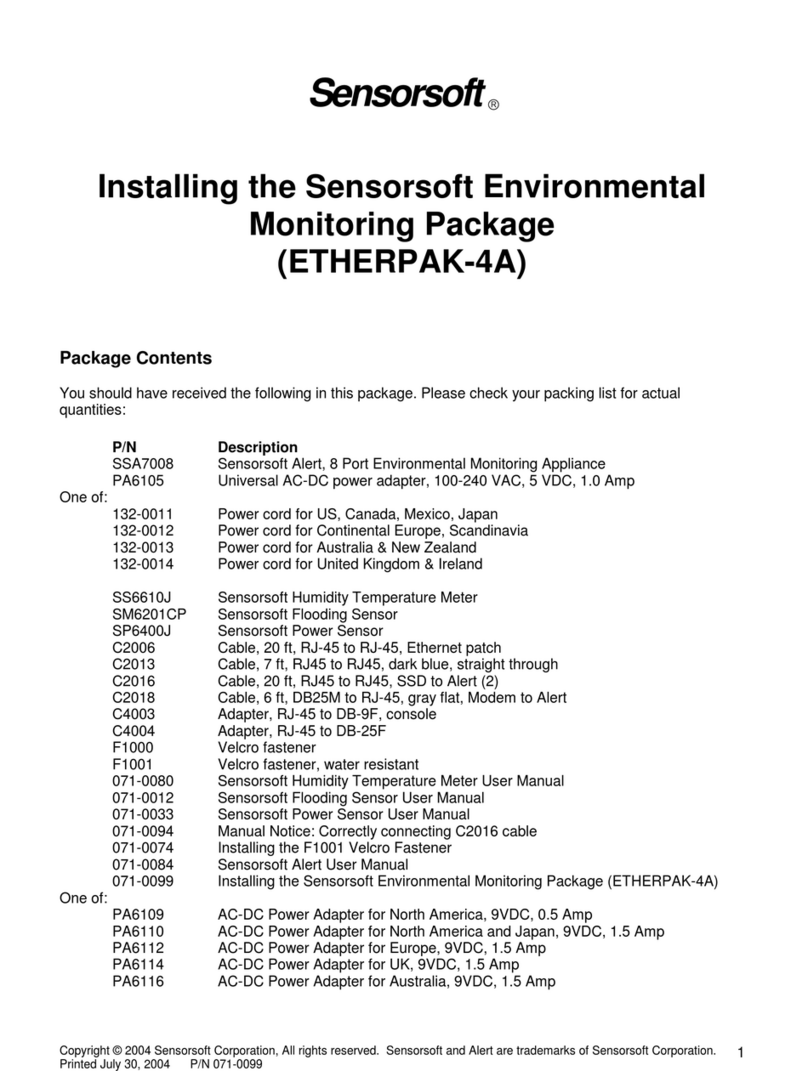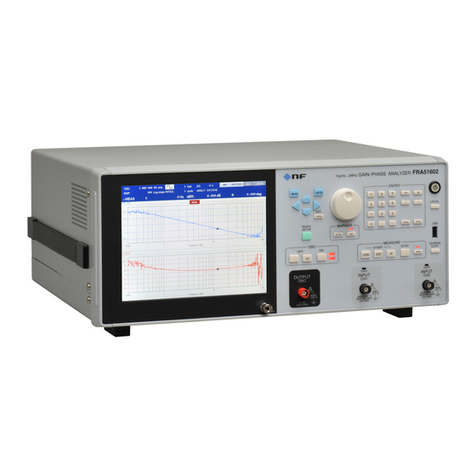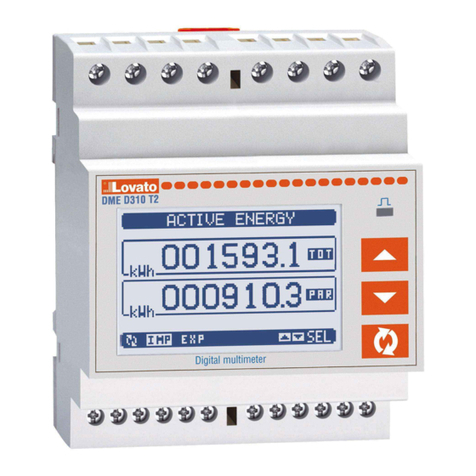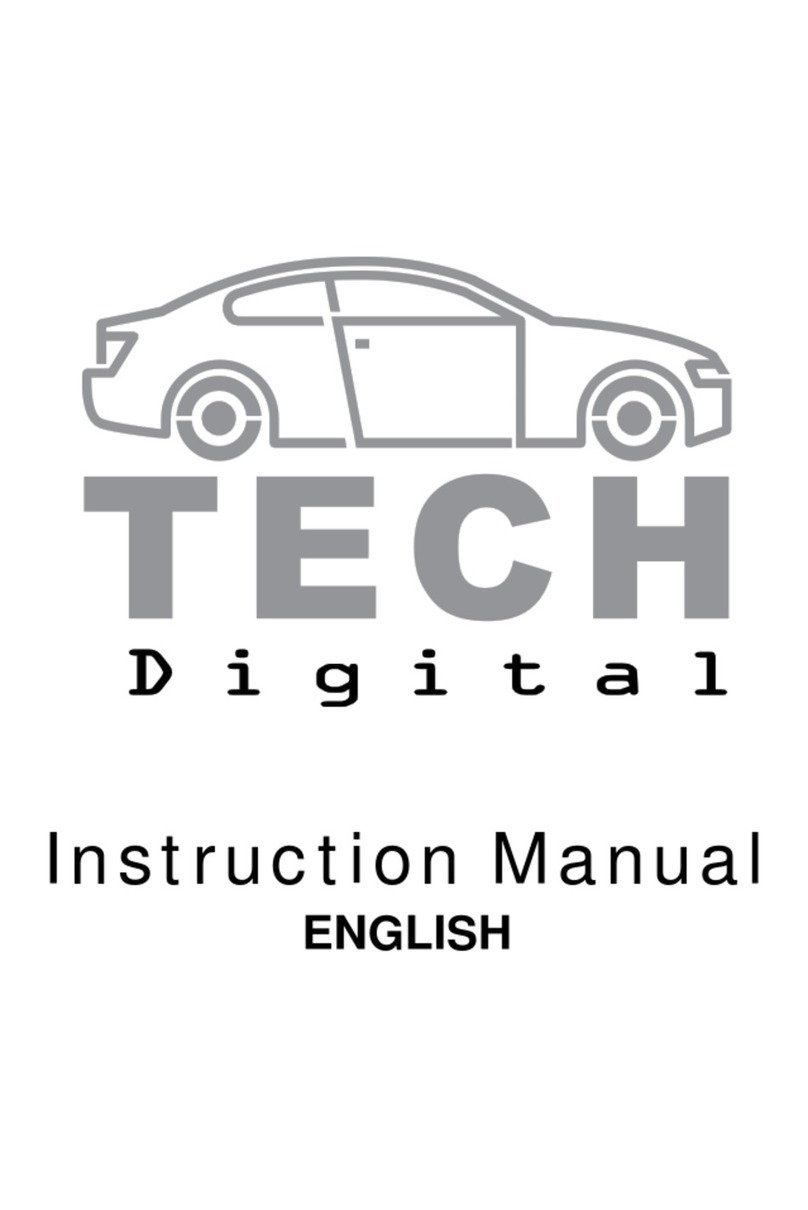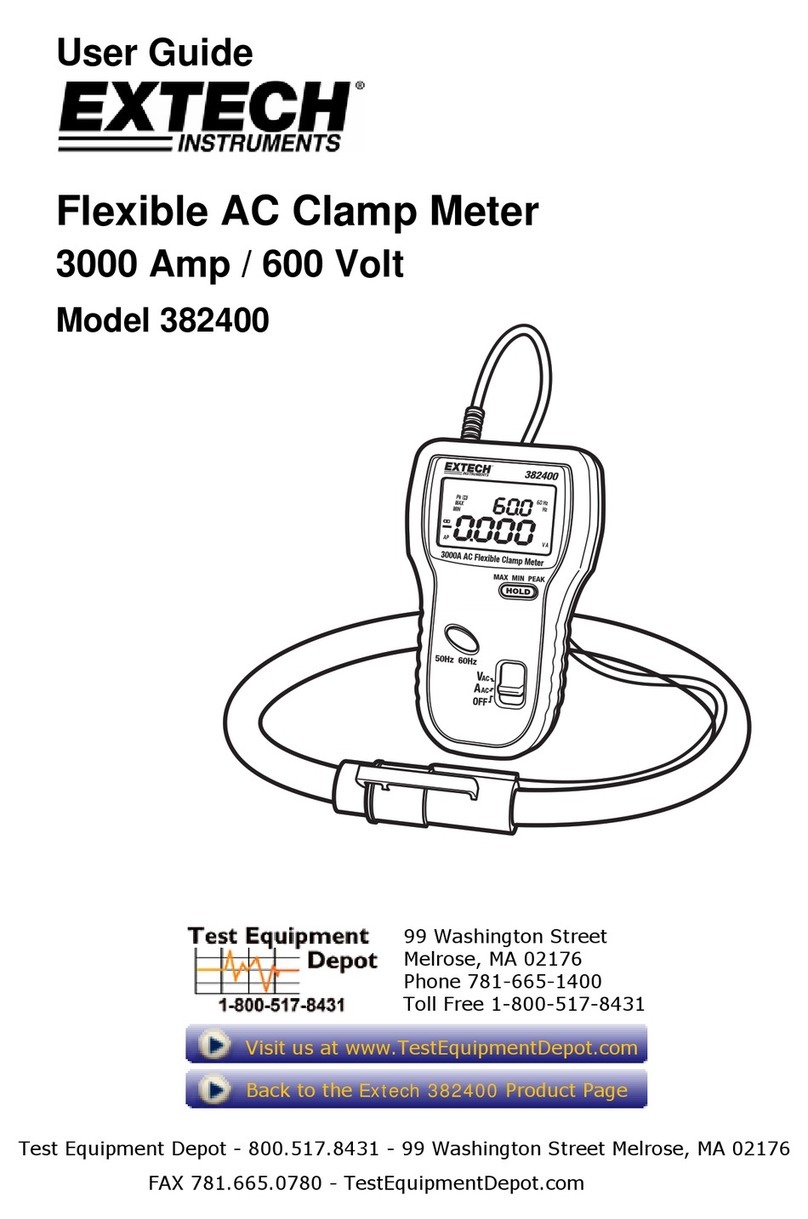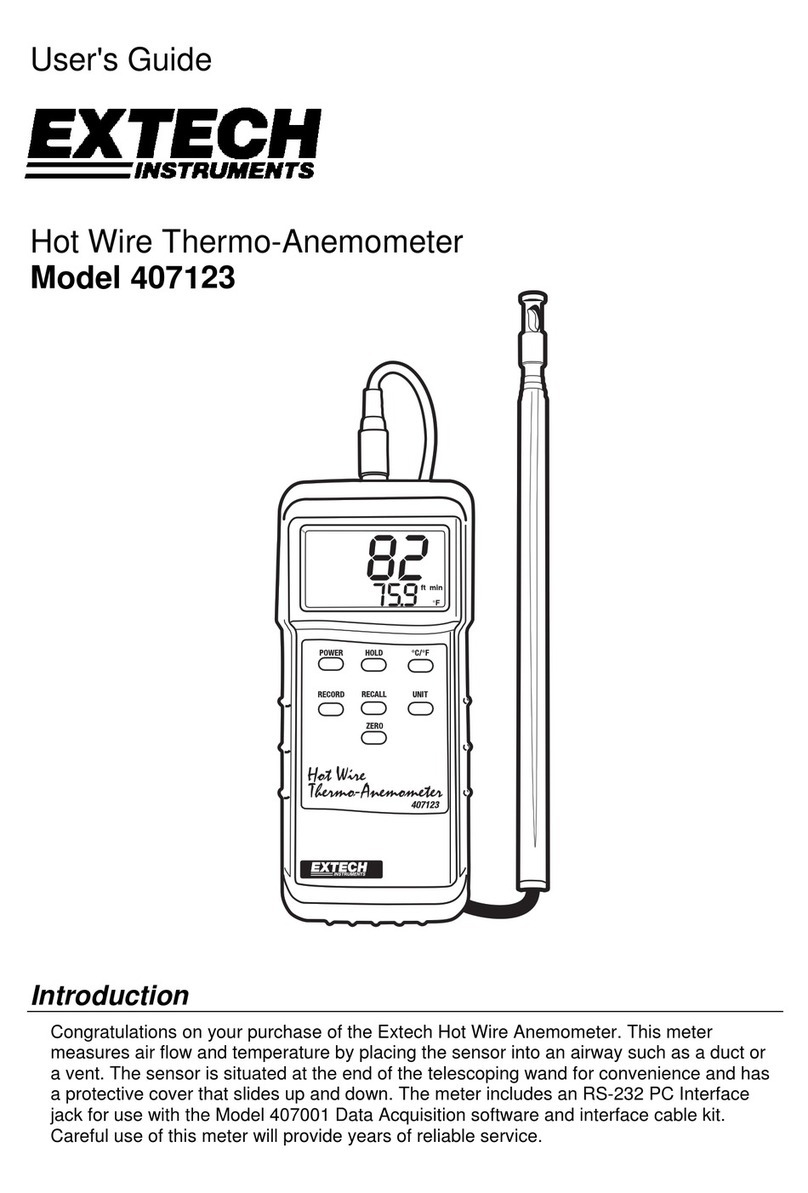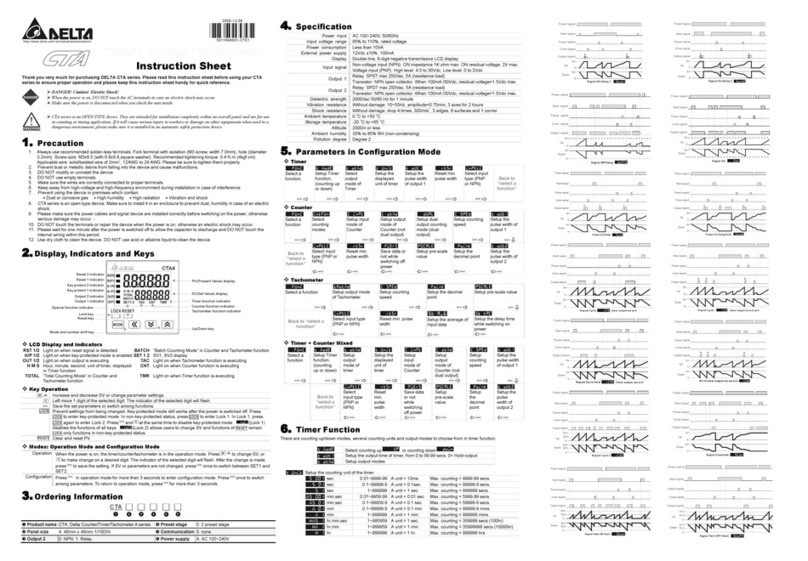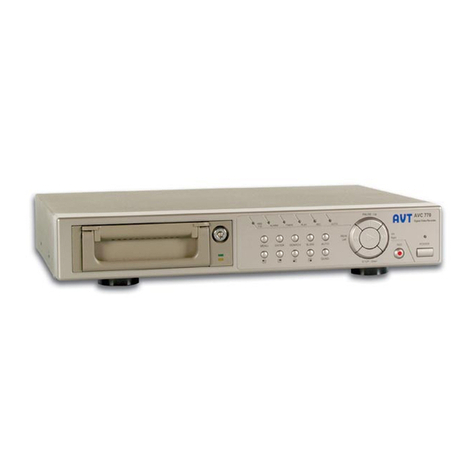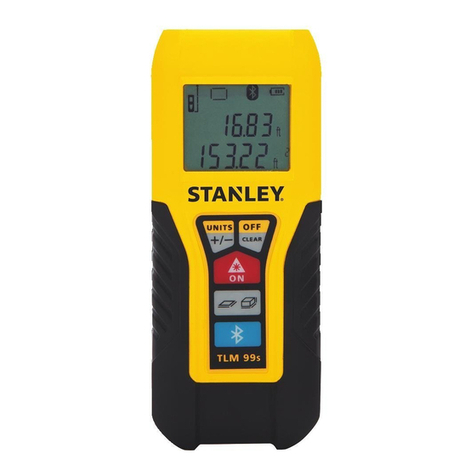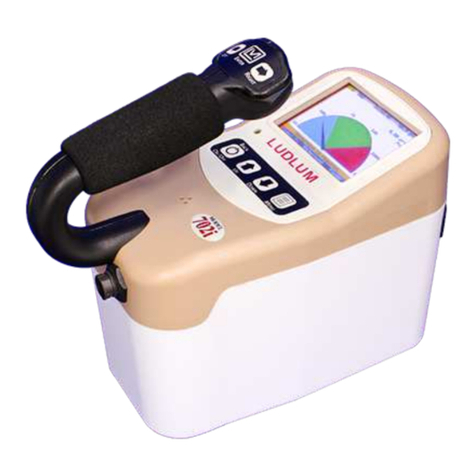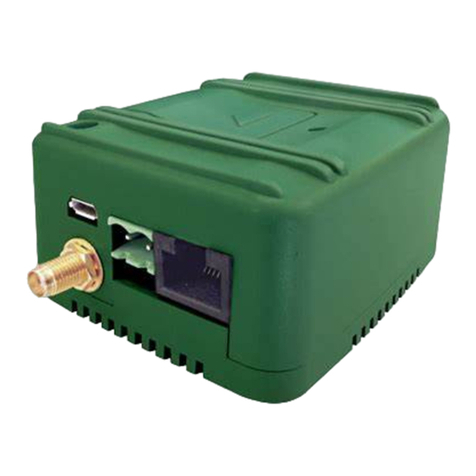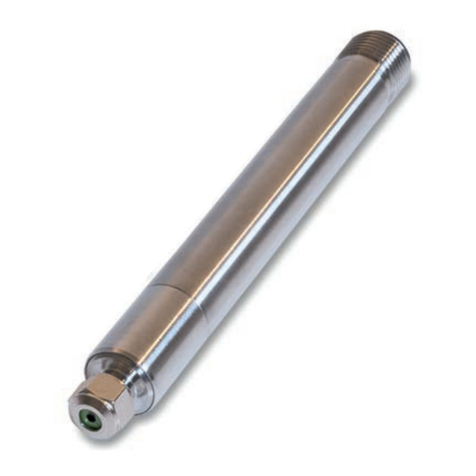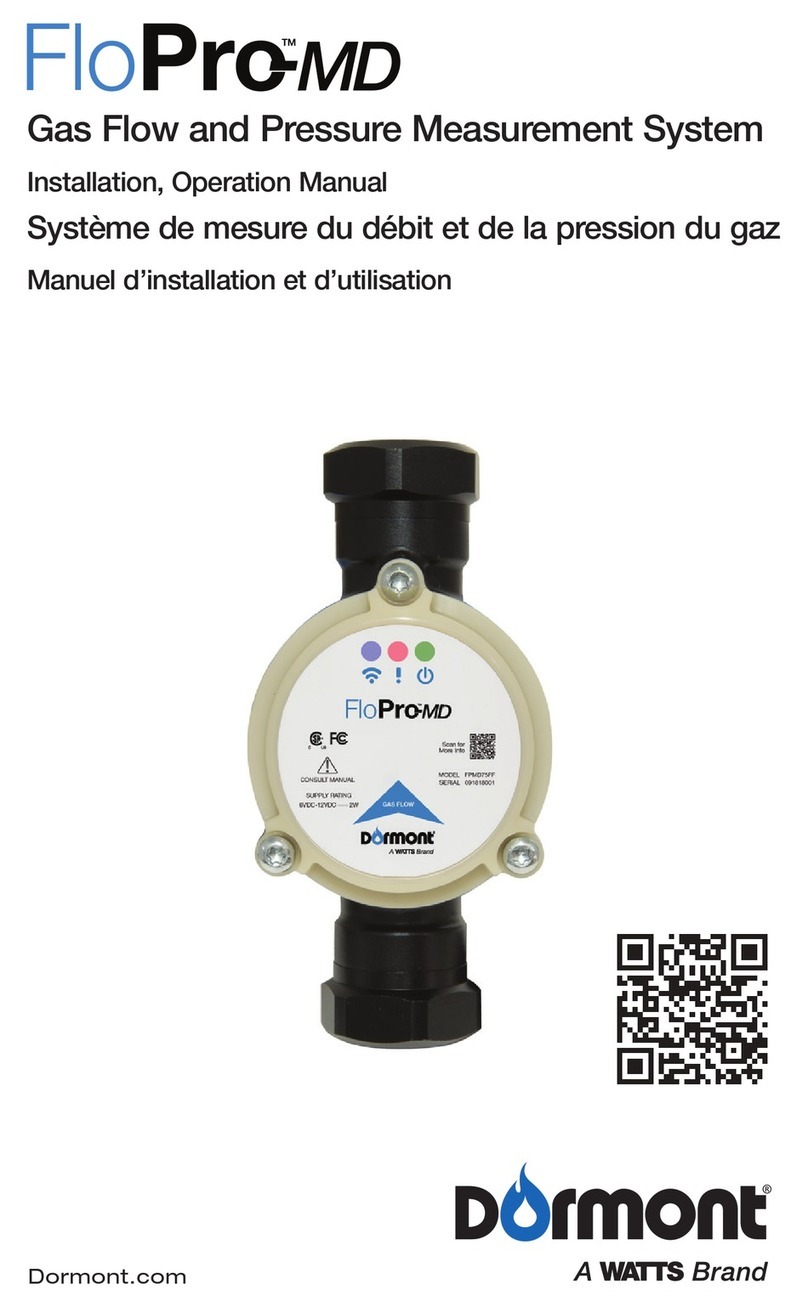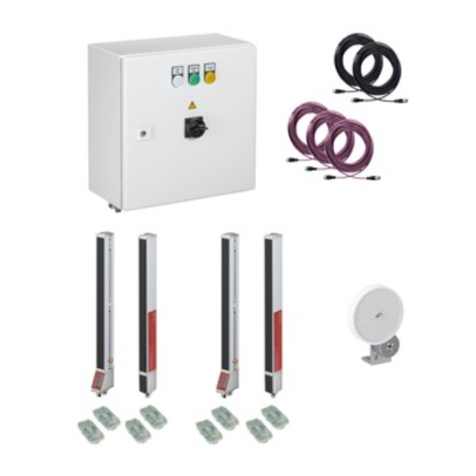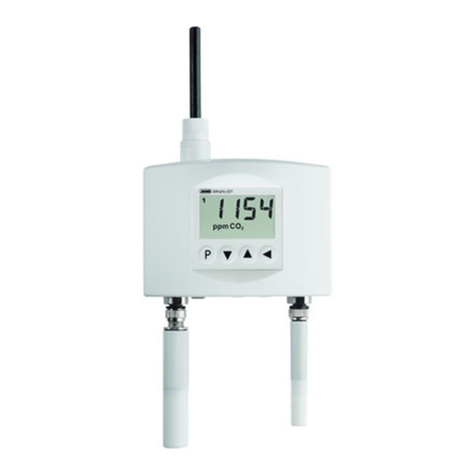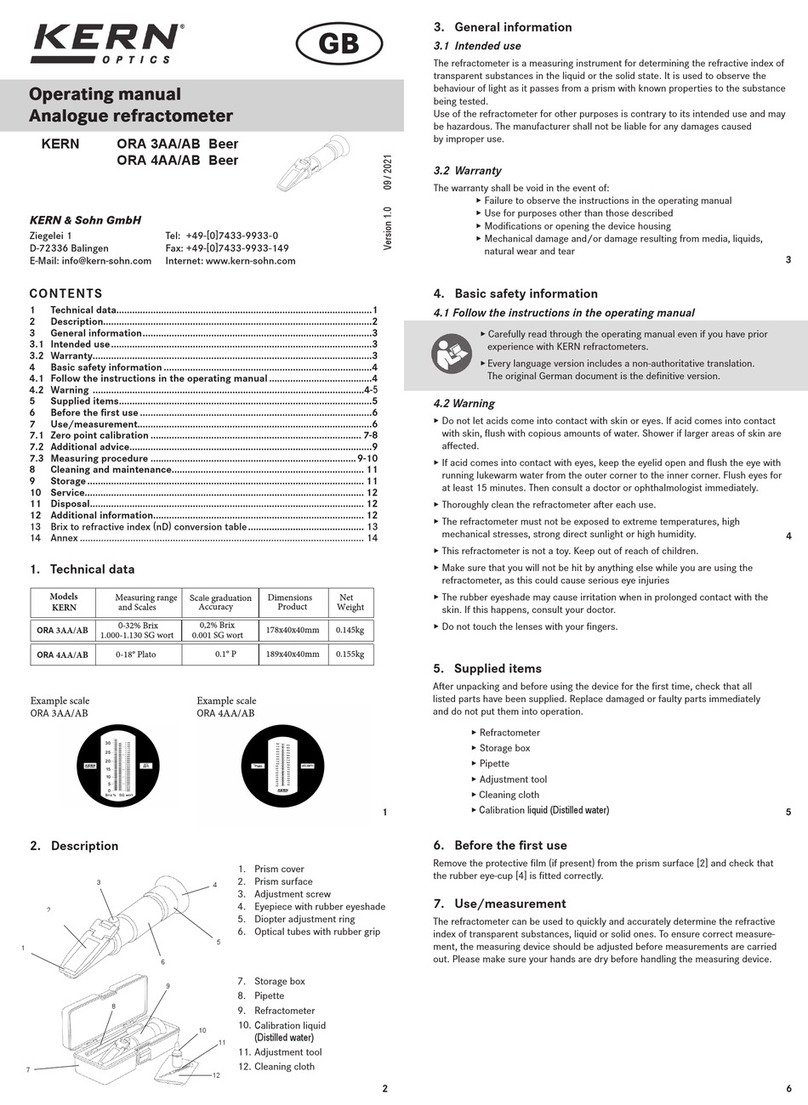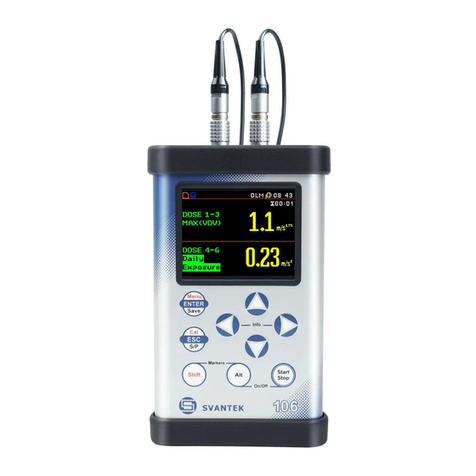Sensorsoft SS6610J User manual

SensorsoftTemperature and Humidity
Meter User’s Manual
Models SS6610J and SS6610C
Manual P/N 071-0080 Rev 7 May 21, 2019
Copyright © 2003-2019 Sensorsoft Corporation, All rights reserved.
Sensorsoft is a registered trademark of Sensorsoft Corporation.


Table of Contents
About this Manual............................................................................................................................ 4
Glossary of Acronyms ..................................................................................................................... 4
Overview.......................................................................................................................................... 5
Installing the Sensorsoft Temperature and Humidity Meter............................................................ 6
Choosing an Installation Location................................................................................................ 6
Connecting the Sensorsoft Temperature and Humidity Meter to a serial port............................ 6
SS6610J (v6.5) Sensorsoft Temperature and Humidity Meter Specifications................................ 8
SS6610C (v6.5) Sensorsoft Temperature and Humidity Meter Specifications............................... 9
Resolution, Accuracy and Calibration ........................................................................................... 10
Avoiding invalid judgments or comparisons .............................................................................. 10
Appropriate measurement instruments to making comparisons............................................... 10
Correct method for making comparisons................................................................................... 11
What to do if you believe the Sensorsoft device is reading incorrectly ..................................... 11
Making extension cables for C-Suffix Sensorsoft Devices............................................................ 12
Making communication cables for J-Suffix Sensorsoft Devices.................................................... 14
Writing custom software programs for the Sensorsoft Temperature and Humidity Meter............ 17
Simple Text Commands Interface ............................................................................................. 17
Sensorsoft Device Monitoring .NET Component for Windows.................................................. 17
Sensorsoft Device Protocol (SSDP) for Advanced Programmers............................................. 17
Getting Help................................................................................................................................... 26
Limited Warranty........................................................................................................................ 26
Technical Support...................................................................................................................... 26
30 Day Money Back Guarantee................................................................................................. 26
Returns....................................................................................................................................... 26

Sensorsoft Temperature and Humidity Meter User’s Manual
4
About this Manual
This document contains information about using the Sensorsoft Temperature and Humidity
Meter.
When other sections of this manual are referenced, italics are used.
The Sensorsoft Temperature and Humidity Meter may be referred to as a device, Sensorsoft
device or SSD (SensorSoft Device) throughout the manual.
Glossary of Acronyms
RWME – Remote Watchman Enterprise software for Windows
RWMC – Remote Watchman Client software for Windows
SCOM – Serial Communications Tool software for Linux and UNIX
SSDP – Sensorsoft Device Protocol
SSA – SensorSoft Alert appliance
SSD – SensorSoft Device

Sensorsoft Temperature and Humidity Meter User’s Manual
Overview
The SS6610J and SS6610C Sensorsoft Temperature and Humidity Meters are RS232 compatible
serial devices based on the Sensorsoft Device Protocol (SSDP). The SS6610J and SS6610C have
built-in temperature and humidity sensors and are intended for applications requiring
measurement of temperature and relative humidity in heated or air conditioned rooms and
warehouses. These products are not conformal coated and are therefore not intended for
environments with high moisture or condensation.
Sensorsoft devices offer the following benefits over other RS232 serial devices:
Powered from the serial port (no external power or battery required)
CRC error detection (detects transmission errors and improves reliability) (SSDP only)
Virtually unlimited cable lengths (1000 ft) (SSDP only)
Plug and go operation (little or no user configuration required)
Sensorsoft makes several SSDP-compliant software applications that permit you to read these
devices, send alerts, record and (in some cases) graph data. These include:
Sensorsoft Remote Watchman Client (RWMC) for Windows
Sensorsoft Remote Watchman Enterprise (RWME) for Windows
Sensorsoft Serial Communications Tool (SCOM) for Linux and UNIX
Sensorsoft Alert Appliance (SSA)
In addition, there are many manufacturers who provide support for Sensorsoft devices within
their products. Some of these include:
ServersCheck Sensor Gateway and software
Lantronix SecureLinx (SLC) Console Manager
As of firmware version 6.5, these Sensorsoft devices respond to Simple Text Commands when
used with a text-based terminal or scripting language. Additionally, we’ve provided several
means for customers to write software integrating Sensorsoft devices into their systems. This is
discussed further in the section, Writing custom software programs for the Sensorsoft
Temperature and Humidity Meter.
5

Sensorsoft Temperature and Humidity Meter User’s Manual
Installing the Sensorsoft Temperature and Humidity
Meter
Installation of the Sensorsoft Temperature and Humidity Meter requires the following steps:
Choosing an Installation Location
Connecting the Sensorsoft Temperature and Humidity Meter to a serial port
Starting the Sensorsoft software. (Please refer to the specific software manual that applies to
your installation.)
Choosing an Installation Location
Locate the Sensorsoft Temperature and Humidity Meter close to the equipment or airflow you’re
monitoring. Since the SS6610J and SS6610C are not waterproof or weatherproof, keep the
following rules in mind:
Keep the Sensorsoft device housing out of contact with direct sunlight, UV exposure, and
dripping water.
Protect the Sensorsoft device from high traffic areas that could wear/damage the housing or
cable.
Never allow the plastic housing of the Sensorsoft device to come into contact with harsh
chemicals or cleaning agents. If the housing needs to be cleaned, use a damp cloth or vacuum
cleaner.
Use a Velcro fastener (P/N F1000 or F1001) to affix the Sensorsoft device to a stable surface.
Connecting the Sensorsoft Temperature and Humidity Meter to a
serial port
If you have a SS6610C (C-Suffix) Sensorsoft Temperature and Humidity Meter, plug its molded
DB-9F connector into an available RS232 serial port connector (DB-9M) on your computer or
device server.
If you have an SS6610J (J-Suffix) Sensorsoft Temperature and Humidity Meter, use the
appropriate C20XX cable to connect this device to your computer or device server. (Please refer
to the Sensorsoft price list for available types of cables.)
If you intend to make a custom cable for a J-Suffix Sensorsoft device, please refer to Making
communication cables for J-Suffix Sensorsoft Devices.
If you are connecting a Sensorsoft Temperature and Humidity Meter to a serial port or
device/console server, configure the port as follows:
1200 bps, 8 bits, no parity, 1 stop bit
6

Sensorsoft Temperature and Humidity Meter User’s Manual
Turn off autobaud
Flow control set to “None”
Non-telnet binary (raw) transfer mode
Assert RTS and DTR always
If using a device/console server, refer to its documentation for more details on the above.
Note the physical port number where you plugged the cable into your computer or device/console
server. If the Sensorsoft device is being plugged into a Windows based computer that has only
one COM port, the port number is usually COM1. If you are using a USB to serial adapter, you
need to refer to the operating system’s serial port (COM) listing. In Microsoft Windows, this is
usually “Device Manager->Ports (COM&LPT).” In Linux or UNIX, refer to the /dev/tty
directory.
7

Sensorsoft Temperature and Humidity Meter User’s Manual
SS6610J (v6.5) Sensorsoft Temperature and Humidity
Meter Specifications
Measurement/Operating Temperature Range: -40 º C to +60 º C (-40 º F to +140 º F)
Temperature Resolution or precision: 0.1 º C (0.18 º F) and 0.5 º C (0.9 º F)
Temperature Accuracy: +/- 0.5 º C (+/- 0.9 º F) between 0 º C to +60 º C (32 º to 140 º F)
+/- 1 º C (1.8 º F) over remainder of temperature range
Relative Humidity Measurement Range: 0 to 100 % RH
Relative Humidity Resolution or precision: 0.1 % RH and 1 % RH
Relative Humidity Accuracy: +/- 3 % RH between 10 % RH and 90 % RH
+/- 5 % RH below 10 % RH and above 90 % RH
Relative Humidity Long Term Stability: < 1 % RH/year
Calibration: Calibrated at the factory. Re-calibration in the field is not possible, but sensors can
be replaced.
Maximum measurement rate: One reading every second
Housing Dimensions: 8 cm (3.1") x 4 cm (1.6") x 2 cm (0.8")
Housing Material: Injection-molded ABS thermoplastic
Housing Colour: Light gray
Sensor type: Semiconductor
Communications connector: 8 position modular jack, (accepts 8 position plug RJ45)
Power source: Port-powered (RTS and DTR, both asserted) or via External DC power connector
Power supply current drain: < 10 mA
External DC power connector: 2.1 mm power jack, automatic polarity correction and over-
voltage protection.
External power supply voltage: 6.0 - 12.0 VDC
Communications Interface: RS232C using TX,RX,RTS,DTR and GND. One device per serial
port.
Maximum communications cable length: 305 m (1000 ft.) using recommended cable type. Low
capacitance shielded cable or UTP is recommended.
Firmware Version: 6.5
Communications Protocol: Sensorsoft Device Protocol (SSDP) Version 2.0 and Simple Text
Commands
Error control: 16 bit CRC (cyclic redundancy checking) for detection of communication errors
between the device and host computer (SSDP only)
8

Sensorsoft Temperature and Humidity Meter User’s Manual
SS6610C (v6.5) Sensorsoft Temperature and Humidity
Meter Specifications
Measurement/Operating Temperature Range: -40 º C to +60 º C (-40 º F to +140 º F)
Temperature Resolution or precision: 0.1 º C (0.18 º F) and 0.5 º C (0.9 º F)
Temperature Accuracy: +/- 0.5 º C (+/- 0.9 º F) between 0 º C to +60 º C (32 º to 140 º F)
+/- 1 º C (1.8 º F) over remainder of temperature range
Relative Humidity Measurement Range: 0 to 100 % RH
Relative Humidity Resolution or precision: 0.1 % RH and 1 % RH
Relative Humidity Accuracy: +/- 3 % RH between 10 % RH and 90 % RH
+/- 5 % RH below 10 % RH and above 90 % RH
Relative Humidity Long Term Stability: < 1 % RH/year
Calibration: Calibrated at the factory. Re-calibration in the field is not possible, but sensors can
be replaced.
Maximum measurement rate: One reading every second
Housing Dimensions: 8 cm (3.1") x 4 cm (1.6") x 2 cm (0.8")
Housing Material: Injection-molded ABS thermoplastic
Housing Color: Light gray
Sensor type: Semiconductor
Communications cable: Integrated 6 m (20 ft.) cable with DB-9F (female) mini D-SUB
connector
Power source: Port-powered (RTS and DTR, both asserted).
Power supply current drain: < 10 mA
Communications Interface: RS232C using TX,RX,RTS,DTR and GND. One device per serial
port.
Maximum extension cable length: 305 m (1000 ft.) using recommended cable type. Low
capacitance shielded cable or UTP is recommended.
Firmware Version: 6.5
Communications Protocol: Sensorsoft Device Protocol (SSDP) Version 2.0 and Simple Text
Commands
Error control: 16 bit CRC (cyclic redundancy checking) for detection of communication errors
between the device and host computer (SSDP).
9

Sensorsoft Temperature and Humidity Meter User’s Manual
Resolution, Accuracy and Calibration
The terms resolution, accuracy and calibration frequently cause misunderstanding for many
individuals who have not been trained in metrology. We explain these terms here and how they
might apply to your application of Sensorsoft devices.
Resolution or precision is the fineness of the measurement. It is usually specified in terms of the
smallest unit that can be resolved.
Accuracy is the trueness of the measurement or how close it can be to the true value (National
Standard). Accuracy is often specified as a percentage (i.e. +/- 3 %) of the reading, or a fixed
value (i.e. +/- 0.5) that can vary from the true value of the reading.
Calibration is a process where accuracy is verified (and often corrected) with respect to a
standard. Calibrations are routinely carried out to certify that a device has not lost its accuracy,
linearity and stability. Calibrations can be carried out at a time interval that is required by your
industry. In many cases, this is at least once every year.
When a calibration or verification takes place, it must always be done with equipment that has
significantly better accuracy and resolution then the device under testing. When a calibration
check is performed on a “Unit under Test” with an instrument traceable to the National Standards
Laboratory, the “Unit under Test” is also considered to be traceable.
Avoiding invalid judgments or comparisons
Using any of the following measurement devices or situations is unacceptable for comparing to,
or judging the accuracy of a Sensorsoft device:
Low cost measurement device purchased from a retail store
Digital display on HVAC or cooling/heating equipment
Location of the active sensing element is unknown or hidden
Measurement device has its active sensing element more than one inch (2.5 cm) away from
the Sensorsoft device’s sensing element
Measurement device has lower accuracy specifications as compared to the Sensorsoft device
Measurement device has unknown accuracy specifications
Measurement device has not been calibrated within one year, has no calibration certificate or
is not traceable to a reference standard
Appropriate measurement instruments to making comparisons
We recommend one of the following instruments (or equivalent with a recently dated traceable
calibration certificate) for judging the accuracy or stability of your Sensorsoft device:
Vaisala HM40 series Hand held Humidity & Temperature Meter (approx. price $500-1000
US)
10

Sensorsoft Temperature and Humidity Meter User’s Manual
Vaisala HMT330 series Humidity & Temperature Transmitter and external probe (Wall
mount, RS232 interface, order with 115/230 VAC power supply, approx. price $1900-2500
US)
More details about the above instruments are available on Vaisala's web site:
https://www.vaisala.com
Correct method for making comparisons
Keep the following points in mind when checking the Sensorsoft device for accuracy or stability:
1. Use one of the above recommended instruments (or equivalent that has a recent calibration
certificate (within one year).
2. The sensing elements of Sensorsoft device and the traceable instrument must be touching or
within one inch (2.5 cm)
3. Allow sufficient time (30-60 minutes) for the Sensorsoft device and the traceable
measurement instrument to acclimatize to the environment.
4. Make sure you know how to get a live (up to the second) temperature or humidity reading
from the Sensorsoft device through its software.
5. For reading the Sensorsoft device during the comparison use the higher resolution variable,
not the lower resolution variable.
6. Have the published accuracy specifications for the Sensorsoft device and the traceable
measurement instrument readily available for comparison.
What to do if you believe the Sensorsoft device is reading incorrectly
If, after following the above method, you find the Sensorsoft device isn’t reading within its stated
specifications, you can obtain an RMA to return it to our factory for repair. See Returns at the end
of this manual. Charges may apply if the unit is out-of-warranty or if we find no evidence that the
device is out-of-calibration.
11

Sensorsoft Temperature and Humidity Meter User’s Manual
Making extension cables for C-Suffix Sensorsoft
Devices
In some applications it’s not possible to use pre-assembled cables. When installing the Sensorsoft
device at a remote location, it may be necessary to run cables through walls, ceilings or conduits
where connectors would get jammed. In this situation it makes sense to terminate the cables on-
site using hand crimp tools. The following details will assist you in this process.
NOTE - A C-suffix Sensorsoft device has a built-in cable. This includes
model SS6610C.
Figure 1: Illustrates a C-suffix Sensorsoft device with a built-in molded cable and DB-9F connector.
IMPORTANT - A properly made extension cable will allow your
Sensorsoft device to operate reliably over long cable lengths up to
305 m (1000 ft) using SSDP-compliant software.
12

Sensorsoft Temperature and Humidity Meter User’s Manual
Figure 2: C2100 cable is used to extend the cable length for model SS6610C. The DB-9F end of the cable plugs into a
DB-9M serial port. The DB-9M end of the cable plugs into the DB-9F connector on the SSD.
PIN-OUT OF THE DB-9F CONNECTOR ON MODEL SS6610C
Note: Only positions used in Sensorsoft device application are shown
Position Function
2 TX (data to computer)
3 RX (data from computer)
4 POWER (connects to DTR on computer)
5 Ground
7 POWER (connects to RTS on computer)
The following are specialized tools and parts needed to make good quality extension cables:
Hand Tools:
Tyco Crimping Tool P/N 90312-1 or 90302-1, for subminiature D pin or socket contacts
Tyco PROCRIMPER P/N 58448-2, for subminiature D pin or socket contacts
Tyco Insertion/Extraction Tool P/N 91285-1, for subminiature D connector contacts
Materials:
CP Technologies CAT5E UTP stranded, P/N E-207-4P-C5-LGY, 1000 ft, light gray, RoHS
(4 pair, 8-#24 AWG wires, category 4 or better, 75 C)
Tyco DB-9 receptacle subminiature D connector (crimp-snap-in), P/N 205203-1 or -3
Tyco DB-25 receptacle subminiature D connector (crimp-snap-in), P/N 205207-1 or 207463-1
Tyco socket crimp contact for subminiature D connectors, P/N 1-66504-0
Tyco pin crimp contact for subminiature D connectors, P/N 1-66506-0
13

Sensorsoft Temperature and Humidity Meter User’s Manual
Making communication cables for J-Suffix Sensorsoft Devices
In some applications it’s not possible to use pre-assembled cables. When installing the Sensorsoft
device at a remote location, it may be necessary to run cables through walls, ceilings or conduits
where connectors would get jammed. In this situation it makes sense to terminate the cables on-
site using hand crimp tools. The following details will assist you in this process.
NOTE - A J-suffix Sensorsoft device has an RJ-45 jack connector. It
accepts a plug-in cable. This includes model SS6610J.
Figure 3: Illustrates a J-suffix Sensorsoft device that accepts a cable with RJ-45 plug
IMPORTANT - A properly made cable will allow your Sensorsoft device
to operate reliably over long cable lengths up to 305 m (1000 ft) using
SSDP-compliant software.
You may connect the Sensorsoft device to the port with as little as three wires (RX,TX and
GND), using inexpensive unshielded telephone wire. However, the host may need to set the
number of retries high in order to overcome the effect of occasional noise/interference and would
also require the use of an external power supply (PA6106 or PA6206) at the Sensorsoft device.
14

Sensorsoft Temperature and Humidity Meter User’s Manual
The Sensorsoft device modular-jack (RJ-45) connector uses the same UTP wire map as 10-
BASE-T. It is therefore possible to use this type of cabling system for Sensorsoft devices.
PIN-OUT OF THE MODULAR 8 POSITION JACK/PLUG ON A SENSORSOFT DEVICE
Note: Terminal No. 1 is the terminal to the extreme left as you face the cable opening, latch tab down.
Terminal Function UTP wire color
1 ST Receive Data white-green
2 Ground green
3 ST Transmit Data white-orange
4 Power +V blue
5 Ground white-blue
6 Ground orange
7 Power +V white-brown
8 Ground brown
The following are specialized tools and parts needed to make good quality cables:
Hand Tools:
Tyco Crimping Tool P/N 1-231652-0 or 2-231652-1, for modular plugs
Tyco 8 position modular die set P/N 853400-1
Tyco Crimping Tool P/N 90312-1 or 90302-1, for subminiature D pin or socket contacts
Tyco PROCRIMPER P/N 58448-2, for subminiature D pin or socket contacts
Tyco Insertion/Extraction Tool P/N 91285-1, for subminiature D connector contacts
Materials:
CP Technologies CAT5E UTP stranded, P/N E-207-4P-C5-LGY, 1000 ft, light gray, RoHS
(4 pair, 8-#24 AWG wires, category 4 or better, 75 C)
Tyco 8 position modular plug for round stranded wire cables, P/N 5-554169-3 (CAT4)
Tyco 8 position modular plug for round stranded wire cables, P/N 5-557961-3 (CAT5)
Tyco DB-9 receptacle subminiature D connector (crimp-snap-in), P/N 205203-1 or -3
Tyco DB-25 receptacle subminiature D connector (crimp-snap-in), P/N 205207-1 or 207463-1
Tyco socket crimp contact for subminiature D connectors, P/N 1-66504-0
Tyco pin crimp contact for subminiature D connectors, P/N 1-66506-0
15

Sensorsoft Temperature and Humidity Meter User’s Manual
Figure 4: The C2000 cable is used to connect a J-suffix Sensorsoft device to most computers or devices that have a
DB-9M serial port. The DB-9F end of the cable plugs into a DB-9M serial port. The RJ-45 end of cable plugs into the
SSD. M indicates male/pin type connector. F indicates female/socket type connector.
Figure 5: The C2012A cable is used to connect a J-suffix Sensorsoft device to multi-port serial cards or device servers
(UDS1100, EDS1100) which have a DB-25F connector with DCE pin-out. The DB-25M end of the cable plugs into a
DB-25F serial port. The RJ-45 end of cable plugs into the SSD. M indicates male/pin type connector. F indicates
female/socket type connector.
16

Sensorsoft Temperature and Humidity Meter User’s Manual
Writing custom software programs for the Sensorsoft
Temperature and Humidity Meter
Sensorsoft provides three methods for allowing your custom software programs to communicate
with this Sensorsoft device, outlined here:
Simple Text Commands Interface
The Simple Text Commands Interface can be used interactively with a terminal program
(HyperTerminal, TeraTerm, Putty, Telnet, Screen, etc.) or by user-written programs and language
scripts. These commands make it possible to read Sensorsoft devices in many systems including
Linux, UNIX and embedded applications. The following single letter (lower case) commands
should be ended with a carriage return and or line feed character:
r read temperature and humidity
m read model number
v read firmware version
This interface outputs temperature readings in Celsius and relative humidity readings in %RH. It
only supports 0.5 C resolution for temperature readings and 1% resolution for humidity readings.
If you need temperatures in Fahrenheit (F), you will need to do a conversion in your software (i.e.
F = 9/5C + 32).
Using this method, we recommend keeping the cabling short (<100 ft) as the Simple Text
Commands Interface does not support the built-in CRC error detection.
Sensorsoft Device Monitoring .NET Component for Windows
This method involves use of the Sensorsoft Device Monitoring.NET Component for creating
software on Windows based systems. It provides a high-level Windows .NET-based API to
implement the Sensorsoft Device Protocol. You can download and learn more about this free
software at: https://www.sensorsoft.com/developers.html
Sensorsoft Device Protocol (SSDP) for Advanced Programmers
This software method is the most advanced way of supporting Sensorsoft devices. It has several
advantages over the Simple Text Commands Interface discussed above. These include:
CRC error detection for use over long serial cables (1000 ft)
higher resolution measurements (0.1)
auto-discovery by reading device ID record
The Sensorsoft Device Protocol uses a binary, packet-formatted, master-slave protocol. Your host
computer (master) must send commands to, and receive responses back from, the Sensorsoft
17

Sensorsoft Temperature and Humidity Meter User’s Manual
device (slave). All data is represented in the little endian format - least significant byte first and
the most significant byte last.
Use the following parameters when programming the serial port where the Sensorsoft device is
connected:
Bit rate:1200 bps
Bits: 8
Parity: none
Stop bits: 1
Flow control: none
Null discard: do not strip NULL bytes
In order to make use of the port-powered feature of the Sensorsoft device, you must enable serial
port lines DTR and RTS when the port is opened. A delay of 1-2 seconds is required after
opening the serial port before any commands are sent to the Sensorsoft device. This delay allows
the Sensorsoft device to power-up correctly and prevents incorrect readings.
You should also be aware that the Sensorsoft device has an inter-packet retry time-out delay. This
delay is one (1) second and is encoded into the Sensorsoft device’s firmware. If your program
sends a command to the Sensorsoft device without a response, your program must wait at least
one (1) second before re-sending that command. Possible reasons that a Sensorsoft device may
ignore your commands can be due to data transmission (CRC) errors or improper power-up delay
during hot-plugging.
Sending SSDP commands to the Sensorsoft device
Each command packet your host sends to the Sensorsoft device must be in the following format:
<CMD-byte> <PACKETlength-bytes> <ADDRESS-bytes> <ARGUMENT-byte> <CRC-bytes>
CMD-byte
A single byte command indicating the desired action you want the Sensorsoft device to perform.
PACKETlength-bytes
Two bytes indicating the total length of the packet from start to finish (includes CRC bytes).
ADDRESS-bytes
The six-byte (48-bit) address of the device you are sending the command to. This is always
“decimal 1.”
ARGUMENT-byte
The number of the Sensorsoft device’s internal register or variable you want to read or write. This
byte is required for commands the request temperature or humidity readings. This byte is not
required for the status command.
CRC-bytes
18

Sensorsoft Temperature and Humidity Meter User’s Manual
A two byte (16 bit) Cyclic Redundancy Check that is calculated on the entire packet from the
CMD byte to the last ARGUMENT byte or ADDRESS byte. In the examples below, the last two
bytes in each command string are CRC bytes that were pre-calculated.
Send the following bytes to request a status reading:
<C1h><0Bh><00h><01h><00h><00h><00h><00h><00h><47h><98h>
Send the following bytes to request a relative humidity reading in % RH (1 % resolution):
<C5h><0Ch><00h><01h><00h><00h><00h><00h><00h><01h><0Eh><49h>
Send the following bytes to request a relative humidity reading in % RH (0.1 % resolution):
<C5h><0Ch><00h><01h><00h><00h><00h><00h><00h><02h><6Dh><79h>
Send the following bytes to request a temperature reading in Celsius (0.5 C resolution):
<C5h><0Ch><00h><01h><00h><00h><00h><00h><00h><03h><4Ch><69h>
Send the following bytes to request a temperature reading in Celsius (0.1 C resolution):
<C5h><0Ch><00h><01h><00h><00h><00h><00h><00h><04h><ABh><19h>
19

Sensorsoft Temperature and Humidity Meter User’s Manual
Receiving SSDP responses from the Sensorsoft device
Each response packet the Sensorsoft device returns is in the following format:
<RESPONSE-byte> <PACKETlength-bytes> <DATA-byte(s)> <CRC-bytes>
RESPONSE-byte
A single byte response code indicating the type of response. Valid codes are 90 hex or 94 hex.
PACKETlength-bytes
Two bytes indicating the total length of the packet from start to finish (includes CRC bytes).
DATA-byte(s)
Most responses return additional data in the form of byte(s). In response to a temperature
command, two bytes are returned for DATA-byte(s). In response to a status command, one byte is
returned for DATA-byte(s). See SENSORSOFT DEVICE STATUS BYTE FORMAT chart.
CRC-bytes
A two byte (16 bit) Cyclic Redundancy Check. This placeholder is filled with CRC bytes
calculated by the Sensorsoft device on the entire packet from the RESPONSE byte to the last
DATA-byte. These bytes allow the host to verify the integrity of the response packet. You may
choose to use or ignore these bytes depending on your programming skill or application.
The Sensorsoft device returns a normal RESPONSE-byte (90 hex) in acknowledgement that the
previous host command was received and executed without errors. The Sensorsoft device only
acknowledges correctly received commands that have no CRC errors. If the Sensorsoft device
detects a CRC error in a received command packet, it does not respond to the command. It is
considered the job of the host to time-out and re-transmit that command packet.
When an internal problem occurs inside the Sensorsoft device, it sends out an abnormal response
byte (94 hex) to any command from the host. If the host receives this response byte, it must
immediately read and interpret the Sensorsoft device’s status to determine the problem. See
SENSORSOFT DEVICE STATUS BYTE FORMAT chart.
The generator polynomial used for the CRC is hexadecimal 1021. The following references
provide information for readers who wish to use the CRC capability;
Calculating CRC’s by Bits and Bytes, Greg Morse, Byte Magazine, September 1986, Pg.
115-124
Implementing CRC's, Jack Crenshaw, Embedded Systems Programming Magazine, January
1992, Pg. 18-45
Technical Aspects of Data Communication, John McNamara, Digital Equipment Press 1982,
Pg. 110-122
Data and Computer Communications, 2nd edition, William Stallings, Macmillan Publishing,
Pg. 107-112
The modem reference: the complete guide to selection, installation, and applications, 2nd
edition, Michael A Banks, Brady Publishing 1991, Pg. 27-42
20
This manual suits for next models
1
Table of contents
Other Sensorsoft Measuring Instrument manuals
